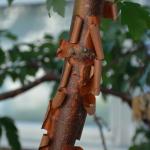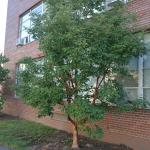A monthly e-newsletter from UMass Extension, published March to October, for home gardeners.
To read the articles in each section of the newsletter, click on the section headings below to expand the content:
Tips of the Month
September is the Month to.....
-
Check certain conifers for spruce spider mites. Spruce spider mite (Oligonychus ununguis) can be found between roughly 2375-2806 GDD’s (base 50°F) on cedar, hemlock, juniper, pine, and spruce. (Need an explanation of what growing degree days are? Visit https://ag.umass.edu/landscape/fact-sheets/growing-degree-days-for-management-of-insect-pests-in-landscape) Look for damage in the form of stippled foliage that may turn yellow to reddish-brown in color. This species of mite may prefer older needles as a food source. Tap branches over a white piece of paper and use magnification to search for mites. If there are more than 10 mites per “tap” over the paper, treatment may be recommended. If you are not 100% certain spruce spider mites are causing the injury seen, send in a sample to be identified prior to conducting any management practices. Samples may be sent to the UMass Plant Diagnostics Laboratory.
-

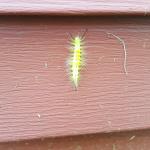 Be aware of the presence of certain tussock moth caterpillars. The caterpillar stage of our native tussock moths, such as the hickory tussock moth (Lophocampa caryae) and the definite tussock moth (Orgyia definita) may be present in the landscape on various trees and shrubs. In general (but not always), it is a good rule of thumb to avoid handling “hairy caterpillars”, such as those of the tussock moths, with your bare hands. For some, an allergic reaction or dermatitis may occur as a result of coming into contact with the hairs. This does not mean we should panic when we see a hairy caterpillar, but just know that it is better to “look, but do not touch”. For more information about the hickory tussock moth and the definite tussock moth, see the Insects section of the following issue of the Landscape Message at https://ag.umass.edu/landscape/landscape-message-aug-24-2018.
Be aware of the presence of certain tussock moth caterpillars. The caterpillar stage of our native tussock moths, such as the hickory tussock moth (Lophocampa caryae) and the definite tussock moth (Orgyia definita) may be present in the landscape on various trees and shrubs. In general (but not always), it is a good rule of thumb to avoid handling “hairy caterpillars”, such as those of the tussock moths, with your bare hands. For some, an allergic reaction or dermatitis may occur as a result of coming into contact with the hairs. This does not mean we should panic when we see a hairy caterpillar, but just know that it is better to “look, but do not touch”. For more information about the hickory tussock moth and the definite tussock moth, see the Insects section of the following issue of the Landscape Message at https://ag.umass.edu/landscape/landscape-message-aug-24-2018. -
Check magnolia’s for magnolia scale crawler activity. The magnolia scale (Neolecanium cornuparvum) is one of two species of very large soft scale insects that can be found on certain magnolias. Roughly between 2155-2800 GDD’s (base 50°F), the crawler (or mobile) stage of the insect may be present. These can be detected by using double-sided sticky tape and tapping this on infested branches, which may yield a collection of scale crawlers stuck to the tape. Heavily infested branches can be pruned out and destroyed, if possible. More information about the magnolia scale can be found here, under “Questions and Answers” at https://ag.umass.edu/landscape/newsletters/hort-notes/hort-notes-2017-vol-288.
-
Be cautious about stinging insects. Often times, when we think that we have been “stung by a bee”, the true culprit is some type of yellowjacket, which is a type of wasp. Yellowjackets frequently interact with humans at the end of the summer due to a shift in their foraging behaviors. Early in the season, they can act as beneficial insects as they are predators of many pest insects such as caterpillars. These protein resources can be useful to them when rearing their young. Later in the season, they may switch to foods high in carbohydrates or sugars, including nectar and honeydew, but also some of our favorite items to pack during outdoor picnics or cookouts (soda and other sugary treats). Unlike European honeybees (Apis mellifera), yellowjackets are capable of stinging multiple times (multiple stings from a single individual). This includes aerial yellowjackets such as the baldfaced hornet and other species in the genus Dolichovespula spp. European honeybees (the workers) can only sting once due to the fact that they have a barbed stinger/ovipositor. This causes the ovipositor to become stuck in the skin, tearing this structure free from the abdomen of the honeybee, thus killing the honeybee. Honeybees are often not aggressive and only attack when otherwise threatened. This may not be the case for yellowjackets.
-
 Finish sealing up any potential points of entry into the home for “fall invaders”. Various insects, such as ladybugs, boxelder bugs, seedbugs, and stink bugs will begin to seek overwintering shelters in warm places, such as homes, throughout the next couple of months. While such invaders do not cause any measurable structural damage, they can become a nuisance, especially when they are present in large numbers. While the invasion has not yet begun, if you are not willing to share your home with such insects, now should be the time to repair torn window screens, repair gaps around windows, doors, and vents, and seal up any other gaps through which they might enter the home.
Finish sealing up any potential points of entry into the home for “fall invaders”. Various insects, such as ladybugs, boxelder bugs, seedbugs, and stink bugs will begin to seek overwintering shelters in warm places, such as homes, throughout the next couple of months. While such invaders do not cause any measurable structural damage, they can become a nuisance, especially when they are present in large numbers. While the invasion has not yet begun, if you are not willing to share your home with such insects, now should be the time to repair torn window screens, repair gaps around windows, doors, and vents, and seal up any other gaps through which they might enter the home. -
Plan fall cleanup of landscapes. In certain cases, a great Integrated Pest Management technique that can help reduce dependence on insecticides can be mechanical/culture management options utilized as a part of fall cleanup. This can include the raking of beds to remove leaves, spent stems, and other fallen woody material. This can help remove hiding places or areas where insects can overwinter and become pests again on trees and shrubs next season. That said, it can also remove areas where certain beneficial insects/pollinators do the same – so if you have a designated pollinator garden, consider leaving that one a little messy for the fall and winter to allow for overwintering habitat for those insects.
-
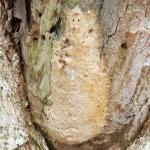 Scout your landscape for gypsy moth egg masses. Are they present in very large numbers? If so, plan your management for 2019 ahead of time. For more information about gypsy moth in 2018 and expectations for 2019, check out the “Trouble Maker of the Month” section here: https://ag.umass.edu/landscape/newsletters/hort-notes/hort-notes-2018-vol-298.
Scout your landscape for gypsy moth egg masses. Are they present in very large numbers? If so, plan your management for 2019 ahead of time. For more information about gypsy moth in 2018 and expectations for 2019, check out the “Trouble Maker of the Month” section here: https://ag.umass.edu/landscape/newsletters/hort-notes/hort-notes-2018-vol-298. -
Report any suspicious and possibly invasive insects to the proper authorities. (There’s never a wrong month to do this.) Concerned about Asian longhorned beetle or suspicious damage on your maple trees? Believe you have emerald ash borer in a town in Massachusetts that has not yet been confirmed? See the following fact sheets for more information about the Asian longhorned beetle and the emerald ash borer in Massachusetts, and who to contact if you are concerned:
o Asian longhorned beetle: https://ag.umass.edu/landscape/fact-sheets/asian-longhorned-beetle
o Emerald ash borer: https://ag.umass.edu/landscape/fact-sheets/emerald-ash-borer
Tawny Simisky, UMass Extension Entomologist
Timely Topics
Fall Mowing Height
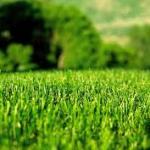 A popular discussion around this time each season centers on the best way to approach mowing height during the fall. A well-known, traditional recommendation calls for reducing mowing height in the fall, but it is prudent to consider the big picture before making a change.
A popular discussion around this time each season centers on the best way to approach mowing height during the fall. A well-known, traditional recommendation calls for reducing mowing height in the fall, but it is prudent to consider the big picture before making a change.
While mowing is the most basic cultural practice applied in the care of turf, mowing height decisions carry substantial implications for turf health. Mowing height directly affects the amount of turfgrass leaf area that is present, and leaf area in turn dictates photosynthetic capacity (the process by which the plant obtains resources for growth and development). As a general rule, the lower you go, the higher the maintenance demands of the turf:
- Mowing frequency increases because the 1/3 rule* interval is smaller.
- A less extensive root system is challenged to capture moisture and nutrients from the soil, thus the need for irrigation and fertilizer typically increases.
- Overall, the plants are less resilient and more susceptible to damage from use, pests, or environmental stresses.
For these reasons, a mowing height that is on the high end of the appropriate range for the use of the turf and the turfgrass species present on the site is the best practice. A mowing height between 3-3.5 inches for the duration of the growing season is typically desirable for most lawn situations. Few solid objectives validate a reduction in mowing height during the fall, but notable exceptions are as follows:
- When a shorter cut is desirable for playability (as in a sports turf or golf situation), or is considered paramount for aesthetics in high-value ornamental turf. Such an approach, of course, comes at the cost of higher maintenance.
- When snow molds are a primary concern. In these cases, minimal leaf area can be desirable going into winter, and therefore a gradual reduction in mowing height during the fall may be warranted. Snow molds, however, are not typically a “first order” problem for most lawn areas. Modification of other practices such as fertility and thatch management are often much more effective for reducing impact from snow molds than a change in mowing height.
While the turf may respond to a lower height without immediate outward signs of stress during the favorable growing conditions of the fall, the net outcome is likely to be detrimental over time. There are many benefits of maintaining a consistent, appropriate mowing height throughout the year. A higher mowing height means more cumulative leaf area, which as noted above translates to greater photosynthetic capacity. Greater photosynthetic capacity later in the season generates more carbohydrate resources that are utilized to effectively fuel recovery from summer stress, root development, tiller and lateral stem formation, and winter hardening: all factors that have significant implications for the long-term health and performance of the turf stand. Greater photosynthetic capacity is particularly helpful in compensating for the effect of progressively shorter days in the fall.
It is also very important to continue regular mowing until the grass stops growing. Many folks prefer to drop the mower a notch (or approximately ¼”-⅓”) at the very last mowing, still using care to avoid scalping, to tidy things up and reduce leaf area before winter. When done properly, this technique will not excessively tax the plants, as growth and photosynthesis have diminished and fall plant processes should be on their way to being completed by that stage of the season.
* The 1/3 rule states that no more than 1/3 of the total leaf area should be removed by a single mowing event. Accordingly, an appropriate mowing height should be determined in advance, and the turf should be cut when it reaches a height around the 1/3 rule threshold. For example, if the desired mowing height is 2", then the turf should receive a first cut when it reaches 3" tall. The exact number of days for how long this will take depends on specific circumstances, as the duration can vary widely based on a number of factors including the desired mowing height, the turf species present, available fertility, and prevailing weather conditions.
Jason D. Lanier, UMass Extension Turf Specialist
News for Gardeners
The 2019 UMass Extension Garden Calendar is Now Available!
 Gardening is enjoyed by so many people — it can ease stress, keep you limber, and even improve your mood! To help keep your plants healthy, productive, and beautiful, the 2019 UMass Garden Calendar offers helpful guidelines, daily tips, and an inspiring garden image each month!
Gardening is enjoyed by so many people — it can ease stress, keep you limber, and even improve your mood! To help keep your plants healthy, productive, and beautiful, the 2019 UMass Garden Calendar offers helpful guidelines, daily tips, and an inspiring garden image each month!
For many years, UMass Extension has worked with the citizens of Massachusetts to help them make sound choices about growing, planting and maintaining plants in their landscapes, including vegetables, backyard fruits, and ornamental plants. Our 2019 calendar continues UMass Extension’s tradition of providing gardeners with useful information. This year’s calendar features the use of tomography to identify internal decay in mature trees that do not yet show any visible symptoms of damage, making it difficult to assess their potential risk in urban and suburban settings.
Each Month Features
- An inspiring garden image
- Daily gardening tips for Northeast growing conditions
- Daily sunrise and sunset times
- Phases of the moon
- Plenty of room for notes
- Low gloss paper for easy writing
Cost: $14
ORDER ONLINE at www.umassgardencalendar.org
Too Much Rain!
This summer was a wet one here in the Pioneer Valley, and many gardeners saw root, crown, and stem rots in their annuals and perennials. There are a number of pathogens that can cause these rots in the summer including Phytophthora, Fusarium, Rhizoctonia, Verticillium, and Sclerotinia. All of these are encouraged by humidity, wetness, and warm temperatures. In addition to encouraging pathogens, chronically soggy soil is detrimental to plant health because water displaces air in the soil, depriving roots of the oxygen they need.
Plant pathologists like me are forever telling people to improve drainage if their soil is too wet. So how do you know if you soil really is poorly drained? Here’s an easy way to test that:
- Dig a hole 12” in diameter and 12” deep.
- Fill the hole with water and let it sit 12-24 hours.
- When it has drained completely, fill the hole with water again.
- Measure and record the water level once every hour until the water is gone. Ideal soil drainage is about 2” per hour average, with hourly rates between 1” and 3”. One inch or less is too slow, and >4” too fast.
While there is nothing you can do about the weather, there are some things you can do to improve poorly drained soil and give your plants a fighting chance should such conditions reoccur next year. Growing in raised beds is chief among these.
Some basic things to consider when contemplating raised beds:
- Location and plant choices. Ideally, plants that like full sun want to have at least 6 hours of direct sunlight per day. Plants that like partial shade will appreciate that shade most in the afternoon. Full shade plants want no more than 3 hours of direct sun. If trees and shrubs are encroaching on your sunny perennial bed, consider pruning. Numerous references on the topic of raised bed construction and maintenance are available; some good ones are listed below.
- Topsoil and compost blends are often used in raised bed construction. Amending the existing soil with compost can also improve drainage. Adding sand can sometimes help, but don’t use sand if your soil contains a lot of clay - mixing sand and clay is how bricks are made! Some references on the topic of soil amendments are listed below.
- Use an edging or framing material for the borders of your bed. Common materials for this use include stone, landscape timbers, and metal edging. Edging will help prevent your lawn from creeping into the bed and the bed from creeping into the lawn.
- Consider installing drip irrigation to make supplemental watering easier when rain is scarce. Drip is preferable to overhead irrigation when it comes to disease control because foliage remains dry.
If raised beds are not for you, you can always make those wet areas work for you by choosing plants that are adapted to wet soils. These include certain varieties of milkweed, hosta, ferns, phlox, Siberian iris, filipendula, and aster.
References for soil amendments:
http://articles.extension.org/pages/61063/materials-to-improve-drainage-in-soil
http://rocklandcce.org/resources/improving-drainage-in-soil-rockland
http://extension.colostate.edu/topic-areas/yard-garden/choosing-a-soil-amendment
References for raised bed construction:
http://chemung.cce.cornell.edu/resources/making-a-raised-bed-garden
https://catalog.extension.oregonstate.edu/sites/catalog/files/project/pdf/fs270_1.pdf
https://cdn-ext.agnet.tamu.edu/wp-content/uploads/2016/05/EHT-078-building-a-raised-garden-bed.pdf
Angela Madeiras, UMass Extension Plant Pathologist
Trouble Maker of the Month
Management recommendations for eastern white pine (Pinus strobus) with symptoms of canopy decline
In light of the recent decline of eastern white pine in the region, many homeowners are eager to treat symptomatic white pines for insect and disease related issues in an attempt to restore vigor to weakened trees. However, management may not be warranted in many cases, especially when the exact cause of decline is unknown. Needle browning in the canopy of eastern white pine is a symptom of stress. Symptoms are the internal and external reaction in a plant as a result of disease/insect infestation/environmental stress. Accurate plant disease and insect diagnosis relies on both symptoms and signs (the actual insect pest or pathogen). A diagnosis based on symptoms alone is tenuous at best; at worst, it’s completely false and may lead to the wrong management strategy. It is likely that environmental stress is having a significant role in the current decline of eastern white pine. Abiotic stresses, such as drought, winter injury or de-icing salts, can produce symptoms similar to disease or insect infestation but cannot be alleviated through chemical treatments.
The first management strategy for any concerned homeowner is to hire a licensed, certified arborist to view the trees. To find one in your area, go to the Massachusetts Arborists Association web site. At present, it is not recommended to cut and remove symptomatic white pines unless, of course, the trees are clearly dead. Many declining trees will flush new needles and shoots. While white pine, like most conifers, relies on one- and two-year-old needles to photosynthesize, some trees may be able to survive this growing season with only the current season’s needles. Additionally, trees harboring needle blight fungi should not be removed if the sole objective is to eradicate fungal pathogens within a small area. Needle blight fungi are pervasive in both landscape and forest settings and eradication is not possible.
Cultural management of eastern white pine should focus on increasing light, particularly to lower canopy branches. White pine requires full sun to thrive and if branches are shaded by overstory or neighboring trees, they will decline over time. Needle blight fungi prefer wet and shaded environments and often develop on interior sections of lower canopy branches. Direct sunlight will dry needles and branches faster and reduce the time needle blight pathogen spores have to germinate and invade. Additionally, light-stressed branches can be preferentially attacked by opportunistic pathogens and insects. If white pines are growing in a dense grove, consider thinning to allow the residual trees a chance to grow outward, which can improve vigor.
Chemical management may be helpful in select cases, such as young trees that were recently transplanted and suffering from establishment stress or white pines planted and pruned as a screen. However, many white pines in the landscape are too large to effectively treat with fungicides and harbor such high levels of inoculum (diseased plant parts that harbor a pathogen, allowing it to overwinter and sporulate) that no amount of fungicide will control the disease.
If needle blight from a fungal pathogen has been confirmed, recommended fungicides for use against the four most prominent needle blight pathogens (Lecanosticta acicola, Lophophacidium dooksii, Bifusella linearis, and Septorioides strobi) and registered for use on ornamentals in Massachusetts (if outside of Mass, check the label) can be found at Management recommendations for eastern white pine (Pinus strobus) with symptoms of canopy decline
As mentioned above, environmental stresses are a likely contributor to the current decline. In addition to needle blight, there are many other potential insect pests or fungal pathogens that could be responsible. Therefore, numerous factors must be considered to create an effective management strategy for declining Eastern white pines.
Nicholas J. Brazee, Ph.D., UMass Extension Plant Pathologist
Plant of the Month
Acer griseum, Paperbark Maple
A great small tree as a specimen or for small landscapes, Acer griseum is slow growing to 20-30’ tall and 15-25’ wide. The common name, Paperbark Maple, hints to the wonderfully ornamental exfoliating bark. The cinnamon red to orange to brown outer bark peels to reveal and contrast with the lighter tan inner bark. Bark on the trunk and stems peels into large curls while some areas can be almost smooth, creating a dramatic look and multiple seasons of interest.
The trifoliate leaves add another form of interest. Leaves are 3-5” long with coarsely toothed leaflets and are green to gray-green on the top and blue-green underneath. Fall color can be variable – sometime orange and red, other times red-green or bronze-green. Flowers occur in April to early May and are not ornamentally significant. Flowers are followed by winged samaras.
Propagation of the species is difficult, which contributes to sometimes low availability in trade. Acer griseum has no serious insect or disease problems, making it a great specimen tree or tree for small areas, and can be used as an understory tree in the woodland garden. It should be planted in a location where the ornamental bark can be appreciated.
Mandy Bayer, Extension Assistant Professor of Sustainable Landscape Horticulture, University of Massachusetts Amherst
Additional Resources
Landscape Message - for detailed timely reports on growing conditions and pest activity
Home Lawn and Garden Resources
Find us on Facebook! www.facebook.com/UMassExtLandscape/
Follow us on Twitter for daily gardening tips and sunrise/sunset times. twitter.com/UMassGardenClip
Diagnostic Services
The UMass Extension Plant Diagnostic Lab provides, for a fee, woody plant and turf disease analysis, woody plant and turf insect identification, turfgrass identification, weed identification, and offers a report of pest management strategies that are research based, economically sound and environmentally appropriate for the situation. Accurate diagnosis for a turf or landscape problem can often eliminate or reduce the need for pesticide use. Sampling procedures, detailed submission instructions and a list of fees.
The UMass Soil and Plant Nutrient Testing Laboratory at the University of Massachusetts Amherst provides test results and recommendations that lead to the wise and economical use of soils and soil amendments. The Routine Soil Analysis fits the needs of most home gardeners. Sampling procedures plus the different tests offered and a list of fees.
Spread the Word!
Share this newsletter with a friend! New readers can subscribe to our Home Gardener E-Mail List.

